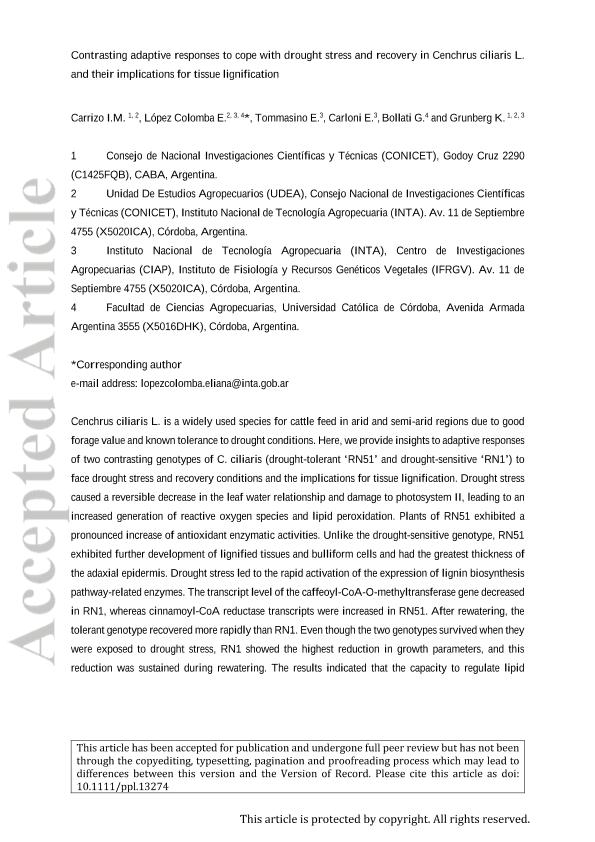Mostrar el registro sencillo del ítem
dc.contributor.author
Carrizo, Iliana Magalí

dc.contributor.author
Lopez Colomba, Eliana

dc.contributor.author
Tommasino, Exequiel Arturo

dc.contributor.author
Carloni, Edgardo José

dc.contributor.author
Bollati, Graciela
dc.contributor.author
Grunberg, Karina Alejandra

dc.date.available
2021-10-19T17:59:06Z
dc.date.issued
2021-06
dc.identifier.citation
Carrizo, Iliana Magalí; Lopez Colomba, Eliana; Tommasino, Exequiel Arturo; Carloni, Edgardo José; Bollati, Graciela; et al.; Contrasting adaptive responses to cope with drought stress and recovery in Cenchrus ciliaris L. and their implications for tissue lignification; Wiley Blackwell Publishing, Inc; Physiologia Plantarum; 172; 2; 6-2021; 762-779
dc.identifier.issn
0031-9317
dc.identifier.uri
http://hdl.handle.net/11336/144323
dc.description.abstract
Cenchrus ciliaris L. is a widely used species for cattle feed in arid and semi-arid regions due to good forage value and known tolerance to drought conditions. Here, we provide insights to adaptive responses of two contrasting genotypes of C. ciliaris (drought-tolerant “RN51” and drought-sensitive “RN1”) to face drought stress and recovery conditions and the implications for tissue lignification. Drought stress caused a reversible decrease in the leaf water relationship and damage to photosystem II, leading to an increased generation of reactive oxygen species and lipid peroxidation. Plants of RN51 exhibited a pronounced increase of antioxidant enzymatic activities. Unlike the drought-sensitive genotype, RN51 exhibited further development of lignified tissues and bulliform cells and had the greatest thickness of the adaxial epidermis. Drought stress led to the rapid activation of the expression of lignin biosynthesis pathway-related enzymes. The transcript level of the caffeoyl-CoA O-methyltransferase gene decreased in RN1, whereas cinnamoyl-CoA reductase transcripts were increased in RN51. After rewatering, the tolerant genotype recovered more rapidly than RN1. Even though the two genotypes survived when they were exposed to drought stress, RN1 showed the highest reduction in growth parameters, and this reduction was sustained during rewatering. The results indicated that the capacity to regulate lipid peroxidation and mitigate oxidative damage could be one of the mechanisms included in tolerance to drought stress. In addition, the development of foliar characteristics, like thickness of the adaxial epidermis, well-developed bulliform cells, and intensive lignified tissues, are considered anatomical adaptive strategies for drought tolerance in C. ciliaris.
dc.format
application/pdf
dc.language.iso
eng
dc.publisher
Wiley Blackwell Publishing, Inc

dc.rights
info:eu-repo/semantics/openAccess
dc.rights.uri
https://creativecommons.org/licenses/by-nc-nd/2.5/ar/
dc.subject
CENCHRUS CILIARIS
dc.subject
DROUGTH STRESS
dc.subject
LIGNIFIED TISSUES
dc.subject
GROWTH PARAMETERS
dc.subject.classification
Otras Ciencias Agrícolas

dc.subject.classification
Otras Ciencias Agrícolas

dc.subject.classification
CIENCIAS AGRÍCOLAS

dc.title
Contrasting adaptive responses to cope with drought stress and recovery in Cenchrus ciliaris L. and their implications for tissue lignification
dc.type
info:eu-repo/semantics/article
dc.type
info:ar-repo/semantics/artículo
dc.type
info:eu-repo/semantics/publishedVersion
dc.date.updated
2021-09-06T16:01:52Z
dc.journal.volume
172
dc.journal.number
2
dc.journal.pagination
762-779
dc.journal.pais
Reino Unido

dc.journal.ciudad
Londres
dc.description.fil
Fil: Carrizo, Iliana Magalí. Instituto Nacional de Tecnología Agropecuaria. Centro de Investigaciones Agropecuarias. Unidad de Estudios Agropecuarios - Consejo Nacional de Investigaciones Científicas y Técnicas. Centro Científico Tecnológico Conicet - Córdoba. Unidad de Estudios Agropecuarios; Argentina
dc.description.fil
Fil: Lopez Colomba, Eliana. Instituto Nacional de Tecnología Agropecuaria. Centro de Investigaciones Agropecuarias. Unidad de Estudios Agropecuarios - Consejo Nacional de Investigaciones Científicas y Técnicas. Centro Científico Tecnológico Conicet - Córdoba. Unidad de Estudios Agropecuarios; Argentina. Instituto Nacional de Tecnología Agropecuaria. Centro de Investigaciones Agropecuarias. Instituto de Fisiología y Recursos Genéticos Vegetales; Argentina. Universidad Católica de Córdoba. Facultad de Ciencias Agropecuarias; Argentina
dc.description.fil
Fil: Tommasino, Exequiel Arturo. Instituto Nacional de Tecnología Agropecuaria. Centro de Investigaciones Agropecuarias. Instituto de Fisiología y Recursos Genéticos Vegetales; Argentina
dc.description.fil
Fil: Carloni, Edgardo José. Instituto Nacional de Tecnología Agropecuaria. Centro de Investigaciones Agropecuarias. Instituto de Fisiología y Recursos Genéticos Vegetales; Argentina
dc.description.fil
Fil: Bollati, Graciela. Universidad Católica de Córdoba. Facultad de Ciencias Agropecuarias; Argentina
dc.description.fil
Fil: Grunberg, Karina Alejandra. Instituto Nacional de Tecnología Agropecuaria. Centro de Investigaciones Agropecuarias. Unidad de Estudios Agropecuarios - Consejo Nacional de Investigaciones Científicas y Técnicas. Centro Científico Tecnológico Conicet - Córdoba. Unidad de Estudios Agropecuarios; Argentina. Instituto Nacional de Tecnología Agropecuaria. Centro de Investigaciones Agropecuarias. Instituto de Fisiología y Recursos Genéticos Vegetales; Argentina
dc.journal.title
Physiologia Plantarum

dc.relation.alternativeid
info:eu-repo/semantics/altIdentifier/doi/http://dx.doi.org/10.1111/ppl.13274
dc.relation.alternativeid
info:eu-repo/semantics/altIdentifier/url/https://onlinelibrary.wiley.com/doi/10.1111/ppl.13274
Archivos asociados
